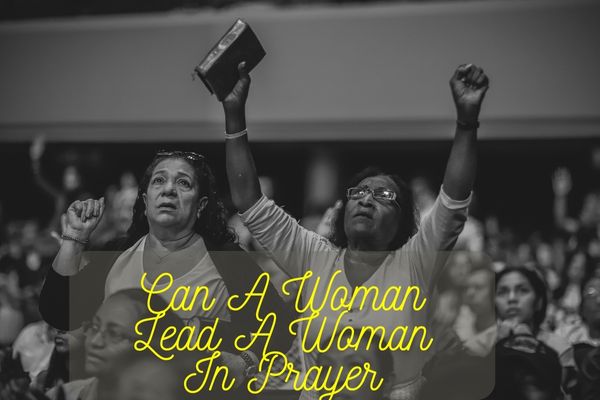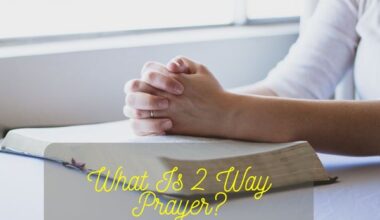Prayer leadership, a significant role within religious practices, often intersects with discussions about gender roles. The question of whether a woman can lead another woman in prayer has sparked debates across various faiths, reflecting both tradition and evolving perspectives.
Can A Woman Lead A Woman In Prayer?
One of the main components of religious practice is prayer, which incorporates an abundance of spirituality, history, and interpretation. However, interwoven inside this complex shade are inquiries that resonate with people of all faiths: Is a female able to guide another female in prayer?
This question, which is full of historical background and current relevance, is evidence of the continuous discussion about gender roles in religious communities. Moving deeper into this investigation reveals a variety of viewpoints as well as the intricate relationship between custom, equality, and changing social standards.
Historical Perspective
Throughout history, women have held diverse roles in religious leadership. However, traditional views have often limited their involvement in leading prayers, varying across different religions and cultures.
Religious Perspectives
In Christianity, interpretations of women leading prayers diverge, ranging from acceptance to restriction based on denominations. Similarly, in Islam, opinions differ, with some schools allowing women to lead other women in prayer while others oppose it.
It is permissible for a woman to lead women in the obligatory Prayers as well as in the optional Prayers. She should not stand in front of rows legislated for men. But she should stand in the middle of the first row of the women when they perform the Prayers in the congregation. If a woman leads the prayer for only one woman, then the woman follower should stand on the right side of the one who leads the Prayer.
The evidence for this is narrated from ‘Aa’ishah and Umm Salamah (the wives of the Prophet) they lead women in prayer and stand in the middle of them. (Imams Ash-Shaafi’i and Al-Bayhaqi narrated it through a good chain). This is the most correct opinion of the Muslim scholars concerning a woman leading other women in Prayers. Though some scholars dislike a woman leading other women in Prayers.
It is forbidden for a woman to lead men in any Prayer regardless of whether they are non-Mahram or unmarriageable, adults or children.
If she is praying alone or in the presence of women only or men who are Mahaarim (unmarriageable persons) for her, she may pray with a loud voice, if no non-Mahram men can hear her voice. This is the preponderant opinion of the Muslim scholars. However, some scholars believe that she is not allowed to pray in a high voice even though no non-Mahram men can hear her.
Following an Imam in Prayers while in a place separate from the mosque other than its courtyard is not correct. But if the rows are connected or the voice of the Imam is heard or following the Imam is possible by seeing him or seeing the persons who are following him in prayer, then praying in that place is permissible. Allah knows best. Judaism also holds varied stances.
In Orthodox Judaism, the role of women in prayer leadership is generally restricted due to interpretations of religious law that limit public roles for women. However, some denominations within Conservative and Reform Judaism ordain women as rabbis and permit them to lead mixed-gender or all-female prayer services.
Other religious traditions, such as Hinduism and Buddhism, offer diverse perspectives on women’s roles in religious leadership, with some denominations allowing and even encouraging female prayer leaders, while others maintain more traditional limitations.
Beyond Theology, Cultural and Societal Influences
The debate surrounding female prayer leadership often transcends purely theological arguments and intersects with broader cultural and societal issues. In some contexts, traditional gender roles and societal expectations regarding male authority play a significant role in shaping attitudes towards female religious leadership. Additionally, concerns about potential social disruption or challenges to established religious hierarchies can contribute to resistance towards change.
However, the growing presence of women in various walks of life, including religious leadership roles, is prompting reevaluations of traditional norms and interpretations. Proponents of female prayer leadership highlight the importance of inclusivity, recognizing the spiritual gifts and leadership potential of women, and promoting gender equality within religious communities.
Navigating the Path Forward
The question of whether a woman can lead a woman in prayer remains a complex and multifaceted issue with no easy answers. Each faith tradition grapples with its theological arguments, historical precedents, and evolving societal contexts. Ultimately, navigating this path forward requires respectful dialogue, open-mindedness, and a willingness to engage with diverse perspectives.
Possible Future Directions
As religious communities continue to grapple with the issue of female prayer leadership, several potential future directions emerge:
- Continued theological discourse: Engaging in respectful dialogue and scholarly exchanges across denominations and faiths can contribute to deeper understanding and potential shifts in interpretations.
- Focus on spiritual leadership: Emphasizing the spiritual qualities and qualifications of individuals, regardless of gender, might offer a more inclusive approach to prayer leadership roles.
- Community-based initiatives: Empowering local communities to explore and implement practices that align with their specific contexts and values can foster organic growth and acceptance.
- Interfaith dialogue: Sharing experiences and perspectives across different religious traditions can broaden understanding and potentially pave the way for greater collaboration and mutual respect.
Conclusion
The question of whether a woman can lead another woman in prayer is multifaceted, reflecting not only religious interpretations but also cultural, societal, and legal dynamics. While some religious traditions allow and embrace this practice, others hold onto more traditional views. As societal norms evolve and discussions around gender equality persist, the role of women in prayer leadership remains a topic of profound debate and contemplation within various faith communities.
The place of women in conducting prayers is still a complex thread in religious practices that is frequently interpreted, debated, and changed. The age-old debate over whether a woman can lead another woman in prayer illustrates the tension that exists between tradition and advancement.
The discussion about women leading prayers endures as civilizations change and gender equality discussions go on, which is evidence of how religion and societal values are complex and dynamic. There is room for inclusivity, flexibility, and a better comprehension of the complex character of spirituality in various theological contexts within this continuing conversation.
Frequently Asked Questions
Is There A Universal Stance On Women Leading Prayers In Different Religions?
No, the acceptance of women leading prayers varies significantly across different religions and denominations within each faith.
What Are Some Challenges Faced By Women Who Aspire To Lead Prayers?
Women often encounter resistance rooted in cultural, societal, and religious norms, facing barriers when attempting to take on prayer leadership roles.
Are There Historical Examples Of Women Leading Prayers In Different Faiths?
Yes, history presents instances of women actively leading prayers in various religious contexts, challenging traditional roles.






